Environmental Unsustainability in Cartagena Bay (Colombia): A Sentinel-3B OLCI Satellite Data Analysis and Terrestrial Nanoparticle Quantification
Abstract
1. Introduction
2. Materials and Methods
2.1. Study Area
2.2. Procedures for Collecting and Analyzing Sampled Sediments
2.3. Using Satellite Images to Collect Geospatial Data
3. Results and Discussion
3.1. Laboratory Analysis of the Sampled Sedimented Material
3.2. Analysis of Satellite Images
4. Conclusions
Author Contributions
Funding
Institutional Review Board Statement
Informed Consent Statement
Data Availability Statement
Acknowledgments
Conflicts of Interest
References
- Neckel, A.; Oliveira, M.L.; Dotto, G.L.; Maculan, L.S.; Bodah, B.W.; Silva, L. Sentinel-3B OLCI satellite imagery and advanced electron microscopy of nanoparticle analysis in a marine estuary and watershed: Robust multi-analytics and geospatial assessment of key contaminants. J. Hydrol. 2022, 612, 128278. [Google Scholar] [CrossRef]
- Fortes, W.M.P.A.; Da Costa Souza, I.; Azevedo, V.; Griboff, J.; Monferrán, M.V.; Wunderlin, D.A.; Matsumoto, S.T.; Fernandes, M.N. Metal/metalloid bioconcentration dynamics in fish and the risk to human health due to water contamination with atmospheric particulate matter from a metallurgical industrial area. Sci. Total Environ. 2023, 902, 166119. [Google Scholar] [CrossRef]
- Aguilera, M.A.; González, M.G. Urban infrastructure expansion and artificial light pollution degrade coastal ecosystems, increasing natural-to-urban structural connectivity. Landsc. Urban Plan. 2023, 229, 104609. [Google Scholar] [CrossRef]
- Guo, W.; Zhang, D.; Zhang, W.; Shen, L.; Pan, K.; Jiang, H.; Zhang, Q. Anthropogenic impacts on the nitrate pollution in an urban river: Insights from a combination of natural-abundance and paired isotopes. J. Environ. Manag. 2023, 333, 117458. [Google Scholar] [CrossRef] [PubMed]
- Souza, I. da. C.; Morozesk, M.; Da Silva Mansano, A.; Mendes, V.A.; Azevedo, V.; Matsumoto, S.T.; Elliott, M.; Monferrán, M.V.; Wunderlin, D.A.; Fernandes, M.N. Atmospheric particulate matter from an industrial area as a source of metal nanoparticle contamination in aquatic ecosystems. Sci. Total Environ. 2021, 753, 141976. [Google Scholar] [CrossRef] [PubMed]
- Zhou, H.; Liu, G.; Zhou, C.; Arif, M.; Sun, M.; Chen, Y.; Liu, Y. Water-assisted-mechanical activation of copper pyrometallurgical tailings for molybdenum leaching and selective removal of environmentally-hazardous elements. Sep. Purif. Technol. 2023, 310, 123088. [Google Scholar] [CrossRef]
- Ayyamperumal, R.; Balasubramanian, M.; Huang, X.; Zhang, C.; Nazir, N.; Li, F. Spatial distribution and seasonal variation of trace hazardous elements contamination in the coastal environment. Environ. Res. 2024, 243, 117780. [Google Scholar] [CrossRef] [PubMed]
- Silva, L.; Lozano, L.P.; Oliveira, M.L.; Da Boit, K.M.; Gonçalves, J.O.; Neckel, A. Identification of hazardous nanoparticles present in the Caribbean Sea for the allocation of future preservation projects. Mar. Pollut. Bull. 2001, 168, 112425. [Google Scholar] [CrossRef] [PubMed]
- ESA. European Space Agency. SENTINEL-3 OLCI Introduction. 2024. Available online: https://sentiwiki.copernicus.eu/web/olci-applications (accessed on 26 May 2024).
- ESA. European Space Agency. SENTINEL-3 OLCI Resolutions. 2024. Available online: https://www.esa.int/Applications/Observing_the_Earth/Copernicus/Sentinel-3/Facts_and_figures (accessed on 26 May 2024).
- ESA. European Space Agency. SENTINEL-3 OLCI Level-2 Water Product Type. 2024. Available online: https://step.esa.int/docs/extra/OLCI_L2_ATBD_Ocean_Colour_Turbid_Water.pdf (accessed on 26 May 2024).
- Moro, L.D.; Maculan, L.S.; Pivoto, D.; Cardoso, G.T.; Pinto, D.; Adelodun, B.; Bodah, B.W.; Santosh, M.; Bortoluzzi, M.G.; Branco, E.; et al. Geospatial Analysis with Landsat Series and Sentinel-3B OLCI Satellites to Assess Changes in Land Use and Water Quality over Time in Brazil. Sustainability 2022, 14, 9733. [Google Scholar] [CrossRef]
- Staehr, S.U.; Holbach, A.; Markager, S.; Stæhr, P.A. Exploratory study of the Sentinel-3 level 2 product for monitoring chlorophyll-a and assessing ecological status in Danish seas. Sci. Total Environ. 2023, 897, 165310. [Google Scholar] [CrossRef]
- Zeng, F.; Song, C.; Cao, Z.; Xue, K.; Lu, S.; Tan, C.; Liu, K. Monitoring inland water via Sentinel satellite constellation: A review and perspective. ISPRS J. Photogramm. Remote Sens. 2023, 204, 340–361. [Google Scholar] [CrossRef]
- Li, Y.; Li, S.; Song, K.; Liu, G.; Wen, Z.; Fang, C.; Shang, Y.; Lyu, L.; Zhang, L. Sentinel-3 OLCI observations of Chinese lake turbidity using machine learning algorithms. J. Hydrol. 2023, 622, 129668. [Google Scholar] [CrossRef]
- Neckel, A.; Oliveira, M.L.; Maculan, L.S.; Adelodun, B.; Toscan, P.C.; Bodah, B.W.; Moro, L.D.; Silva, L. Terrestrial nanoparticle contaminants and geospatial optics using the Sentinel-3B OLCI satellite in the Tinto River estuary region of the Iberian Peninsula. Mar. Pollut. Bull. 2023, 187, 114525. [Google Scholar] [CrossRef] [PubMed]
- Hu, G.; Cao, J. Metal-containing nanoparticles derived from concealed metal deposits: An important source of toxic nanoparticles in aquatic environments. Chemosphere 2019, 224, 726–733. [Google Scholar] [CrossRef] [PubMed]
- Cao, S.; Liang, S.; Li, Y. Adsorption and environmental behavior of mercury on suspended particulate matter from the Yellow River and Xiaoqing River estuaries. Sci. Total Environ. 2023, 893, 164860. [Google Scholar] [CrossRef] [PubMed]
- Casso-Hartmann, L.; Rojas-Lamos, P.; McCourt, K.; Vélez-Torres, I.; Barba-Ho, L.E.; Bolaños, B.W.; Montes, C.L.; Mosquera, J.; Vanegas, D. Water pollution and environmental policy in artisanal gold mining frontiers: The case of La Toma, Colombia. Sci. Total Environ. 2022, 852, 158417. [Google Scholar] [CrossRef]
- Gari, S.R.; Guerrero, C.E.O.; A-Uribe, B.; Icely, J.; Newton, A. A DPSIR-analysis of water uses and related water quality issues in the Colombian Alto and Medio Dagua Community Council. Water Sci. 2018, 32, 318–337. [Google Scholar] [CrossRef]
- Giarratano, E.; Di Mauro, R.; Silva, L.; Tomba, J.P.; Hernández-Moresino, R.D. The Chubut River estuary as a source of microplastics and other anthropogenic particles into the Southwestern Atlantic Ocean. Mar. Pollut. Bull. 2022, 185, 114267. [Google Scholar] [CrossRef] [PubMed]
- Garcés-Ordóñez, O.; Díaz, L.F.E.; Cardoso, R.P.; Muniz, M.C. The impact of tourism on marine litter pollution on Santa Marta beaches, Colombian Caribbean. Mar. Pollut. Bull. 2020, 160, 111558. [Google Scholar] [CrossRef]
- Rangel-Buitrago, N.; Gracia, A. From the closet to the shore: Fashion waste pollution on Colombian Central Caribbean beaches. Mar. Pollut. Bull. 2024, 199, 115976. [Google Scholar] [CrossRef]
- Díaz-Mendoza, C.; Ordiales, P.A.; Bustos, M.L.; Cervantes, O.; Palacios-Moreno, M.; San-Martin, T.V.; Lopes, G.K.; Vallejo, M.I.; Mouthon-Bello, J.; Gutiérrez, L. Abundance and distribution of cigarette butts on the sand of five touristic beaches in Latin America during the COVID-19 pandemic. Mar. Pollut. Bull. 2023, 194, 115306. [Google Scholar] [CrossRef]
- Wang, Y.; Yuan, Q.; Zhou, S.; Zhang, L. Global spatiotemporal completion of daily high-resolution TCCO from TROPOMI over land using a swath-based local ensemble learning method. ISPRS J. Photogramm. Remote Sens. 2022, 194, 167–180. [Google Scholar] [CrossRef]
- Pommier, M. Estimations of NOx emissions, NO2 lifetime and their temporal variation over three British urbanised regions in 2019 using TROPOMI NO2 observations. Environ. Sci. 2023, 3, 408–421. [Google Scholar] [CrossRef]
- Rodríguez-Benito, C.V.; Navarro, G.; Caballero, I. Using Copernicus Sentinel-2 and Sentinel-3 data to monitor harmful algal blooms in Southern Chile during the COVID-19 lockdown. Mar. Pollut. Bull. 2020, 161, 111722. [Google Scholar] [CrossRef] [PubMed]
- Polikarpov, I.; Al-Yamani, F.; Petrov, P.; Saburova, M.; Mihalkov, V.; Al-Enezi, A. Phytoplankton bloom detection during the COVID-19 lockdown with remote sensing data: Using Copernicus Sentinel-3 for north-western Arabian/Persian Gulf case study. Mar. Pollut. Bull. 2021, 171, 112734. [Google Scholar] [CrossRef] [PubMed]
- Rangel-Buitrago, N.; Williams, A.T.; Micallef, A.; Neal, W.J.; Pilkey, O.H. Not all that glitters is gold: Can the real scenic value of the Colombian Caribbean coast be restored? Ocean Coast. Manag. 2022, 227, 106292. [Google Scholar] [CrossRef]
- DANE. National Administrative Department of Statistics. Results National Census of Población of Vivienda, Santa Marta, Magdalena. 2021. Available online: https://www.dane.gov.co/files/investigaciones/planes-departamentos-ciudades/211022-InfoDane-Cartagena-Bolivar.pdf (accessed on 29 August 2023).
- Tosic, M.; Martins, F.; Lonin, S.A.; Izquierdo, A.; Restrepo, J.D. Hydrodynamic modelling of a polluted tropical bay: Assessment of anthropogenic impacts on freshwater runoff and estuarine water renewal. J. Environ. Manag. 2019, 236, 695–714. [Google Scholar] [CrossRef] [PubMed]
- Acosta-Coley, I.; Méndez-Cuadro, D.; Rodríguez-Cavallo, E.; De La Rosa, J.; Olívero-Verbel, J. Trace elements in microplastics in Cartagena: A hotspot for plastic pollution at the Caribbean. Mar. Pollut. Bull. 2019, 139, 402–411. [Google Scholar] [CrossRef]
- Espinosa-Díaz, L.F.; Sánchez-Cabeza, J.; Sericano, J.L.; Parra, J.P.; Ibarra-Gutiérrez, K.P.; Garay-Tinoco, J.A.; Portela, J.I.C.; Alonso-Hernández, C.; Ruíz-Fernández, A.C.; Quejido-Cabezas, A.J.; et al. Sedimentary record of the impact of management actions on pollution of Cartagena bay, Colombia. Mar. Pollut. Bull. 2021, 172, 112807. [Google Scholar] [CrossRef]
- Montero, A.A.G.; Costa-Redondo, L.C.; Vasco-Echeverri, Ó.; Rengifo, V.A.A. Microplastic pollution in coastal areas of Colombia: Review. Mar. Environ. Res. 2023, 190, 106027. [Google Scholar] [CrossRef]
- Acuña, C.; Betancur, J.D.; De Jesús Arrieta Baldovino, J.; Barboza, G.; Saba, M. Analysis of Dispersivity in Marine Clays of Cartagena de Indias, Colombia. Geosciences 2023, 13, 162. [Google Scholar] [CrossRef]
- Neckel, A.; Osorio-Martinez, J.; Pinto, D.; Bodah, B.W.; Adelodun, B.; Silva, L. Hazardous elements present in coal nanoparticles in a Caribbean port region in Colombia. Sci. Total Environ. 2022, 838, 156363. [Google Scholar] [CrossRef] [PubMed]
- Neckel, A.; Oliveira, M.L.; Bolaño, L.J.C.; Maculan, L.S.; Moro, L.D.; Bodah, E.T.; Moreno-Ríos, A.L.; Bodah, B.W.; Silva, L. Biophysical matter in a marine estuary identified by the Sentinel-3B OLCI satellite and the presence of terrestrial iron (Fe) nanoparticles. Mar. Pollut. Bull. 2021, 173, 112925. [Google Scholar] [CrossRef] [PubMed]
- Caballero-Gallardo, K.; Alcala-Orozco, M.; Barraza-Quiroz, D.; De La Rosa, J.; Olívero-Verbel, J. Environmental risks associated with trace elements in sediments from Cartagena Bay, an industrialized site at the Caribbean. Chemosphere 2020, 242, 125173. [Google Scholar] [CrossRef] [PubMed]
- Graca, B.; Zgrundo, A.; Zakrzewska, D.; Rzodkiewicz, M.; Karczewski, J. Origin and fate of nanoparticles in marine water—Preliminary results. Chemosphere 2018, 206, 359–368. [Google Scholar] [CrossRef]
- Vanhellemont, Q.; Ruddick, K. Atmospheric correction of Sentinel-3/OLCI data for mapping of suspended particulate matter and chlorophyll-a concentration in Belgian turbid coastal waters. Remote Sens. Environ. 2021, 256, 112284. [Google Scholar] [CrossRef]
- Abdallah, K.W.; Samar, F.; Djabourabi, A.; Harid, R.; Izeboudjen, H.; Bachari, N.E.I.; Houma-Bachari, F. A preliminary assessment of Sentinel-3 ocean and land color instrument data for the estimation of chlorophyll-a concentration using bio-optical methods in Annaba Bay and El Kala’s coast (Algerian Basin). Reg. Stud. Mar. Sci. 2023, 61, 102882. [Google Scholar] [CrossRef]
- Huang, Y. Triangular irregular network generation and topographical modeling. Comput. Ind. 1989, 12, 203–213. [Google Scholar] [CrossRef]
- Arnone, E.; Francipane, A.; Dialynas, Y.G.; Noto, L.; Bras, R.L. Implications of terrain resolution on modeling rainfall-triggered landslides using a TIN- based model. Environ. Model. Softw. 2021, 141, 105067. [Google Scholar] [CrossRef]
- Moro, L.D.; Maculan, L.S.; Neckel, A.; De Vargas Mores, G.; Pivoto, D.; Bodah, E.T.; Bodah, B.W.; Oliveira, M.L. Geotechnologies applied to the analysis of buildings involved in the production of poultry and swine to the integrated food safety system and environment. J. Environ. Chem. Eng. 2021, 9, 106475. [Google Scholar] [CrossRef]
- Kim, H.; Kim, H.; Cho, S. Improving spherical k-means for document clustering: Fast initialization, sparse centroid projection, and efficient cluster labeling. Expert Syst. Appl. 2020, 150, 113288. [Google Scholar] [CrossRef]
- Li, X.; Yao, R.; Liu, M.; Costanzo, V.; Yu, W.; Wang, W.; Short, C.A.; Li, B. Developing urban residential reference buildings using clustering analysis of satellite images. Energy Build. 2018, 169, 417–429. [Google Scholar] [CrossRef]
- Naghizadeh, A.; Metaxas, D.N. Condensed Silhouette: An optimized filtering process for cluster selection in K-Means. Procedia Comput. Sci. 2020, 176, 205–214. [Google Scholar] [CrossRef]
- Tardioli, G.; Kerrigan, R.; Oates, M.; O’Donnell, J.; Finn, D. Identification of representative buildings and building groups in urban datasets using a novel pre-processing, classification, clustering and predictive modelling approach. Build. Environ. 2018, 140, 90–106. [Google Scholar] [CrossRef]
- Mohanavelu, A.; Shrivastava, S.; Naganna, S.R. Streambed pollution: A comprehensive review of its sources, eco-hydro-geo-chemical impacts, assessment, and mitigation strategies. Chemosphere 2022, 300, 134589. [Google Scholar] [CrossRef] [PubMed]
- Kohrs, D.; Volkmann, J.; Wegner, H.A. Influence of substitution on the supramolecular chemistry of Cycloparaphenylene-Fullerene complexes. Eur. J. Org. Chem. 2023, 26, e202300575. [Google Scholar] [CrossRef]
- Silva, L.; Dotto, G.L.; Pinto, D.; Oliveira, M.L. Nanoparticles and interfaces with toxic elements in fluvial suspended sediment. Mar. Pollut. Bull. 2021, 168, 112405. [Google Scholar] [CrossRef]
- Oliveira, M.L.; Dotto, G.L.; Pinto, D.; Neckel, A.; Silva, L. Nanoparticles as vectors of other contaminants in estuarine suspended sediments: Natural and real conditions. Mar. Pollut. Bull. 2021, 168, 112429. [Google Scholar] [CrossRef]
- Suo, A.; Li, H.; Zhou, W.; Jiao, M.; Zhang, L.; Yue, W. Estimation of ecological carrying capacity of small-scale fish in marine ranch of the Pearl River Estuary, China. Reg. Stud. Mar. Sci. 2023, 61, 102901. [Google Scholar] [CrossRef]
- Zhu, S.; Xu, L. Many-objective fuzzy centroids clustering algorithm for categorical data. Expert Syst. Appl. 2018, 96, 230–248. [Google Scholar] [CrossRef]
- Giannini, F.; Hunt, B.P.V.; Jacoby, D.; Costa, M. Performance of OLCI Sentinel-3A satellite in the Northeast Pacific coastal waters. Remote Sens. Environ. 2021, 256, 112317. [Google Scholar] [CrossRef]
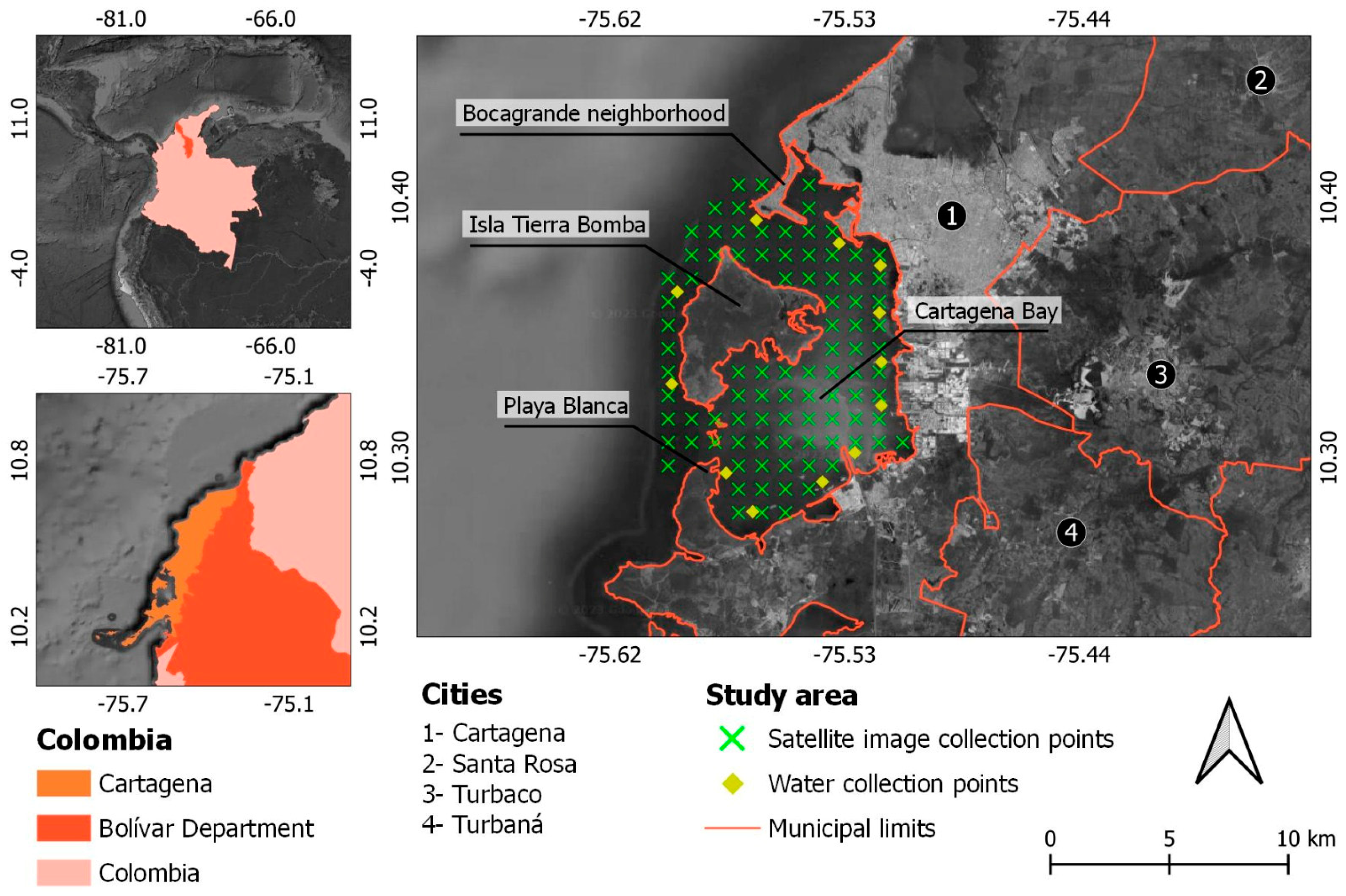
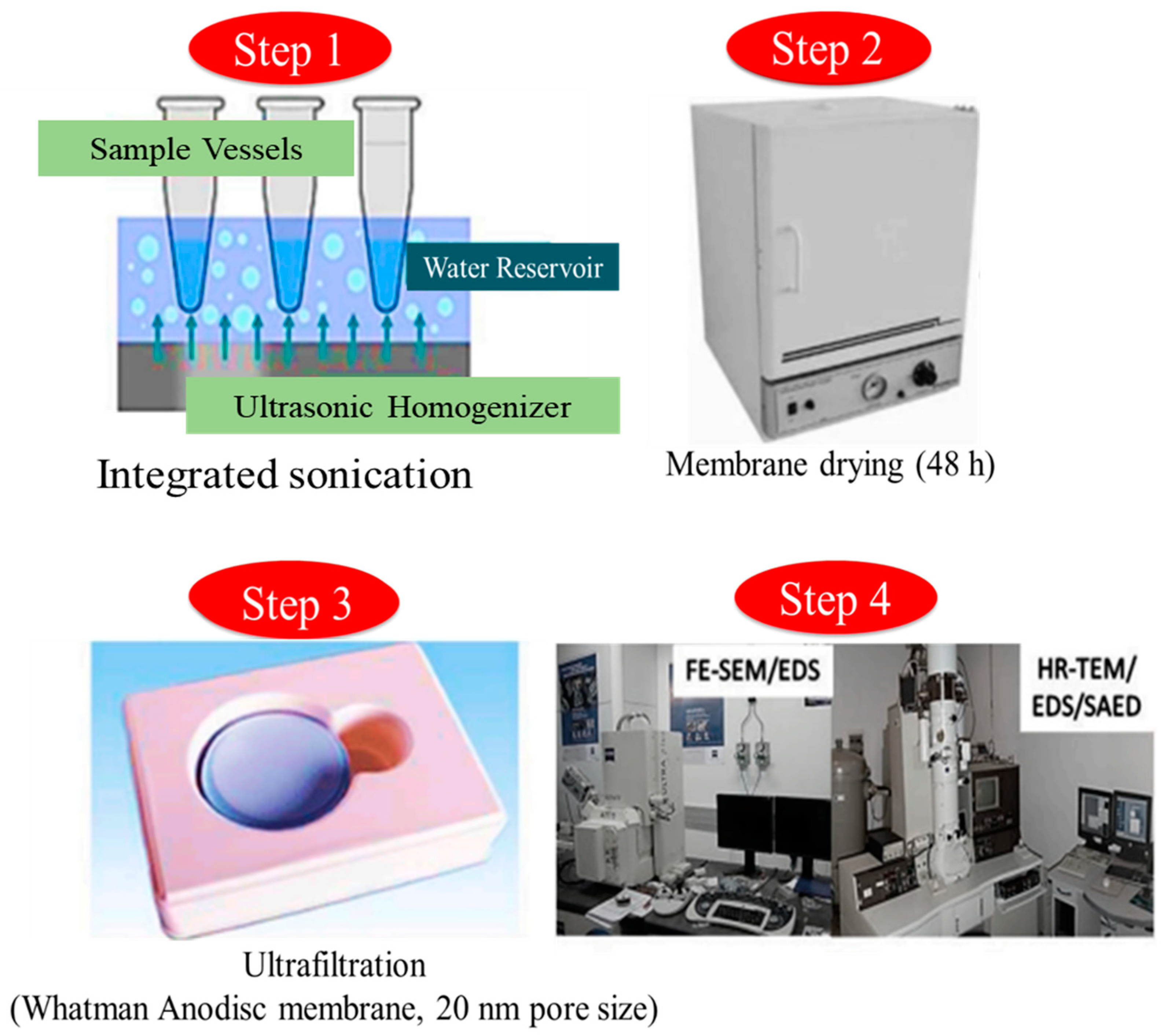
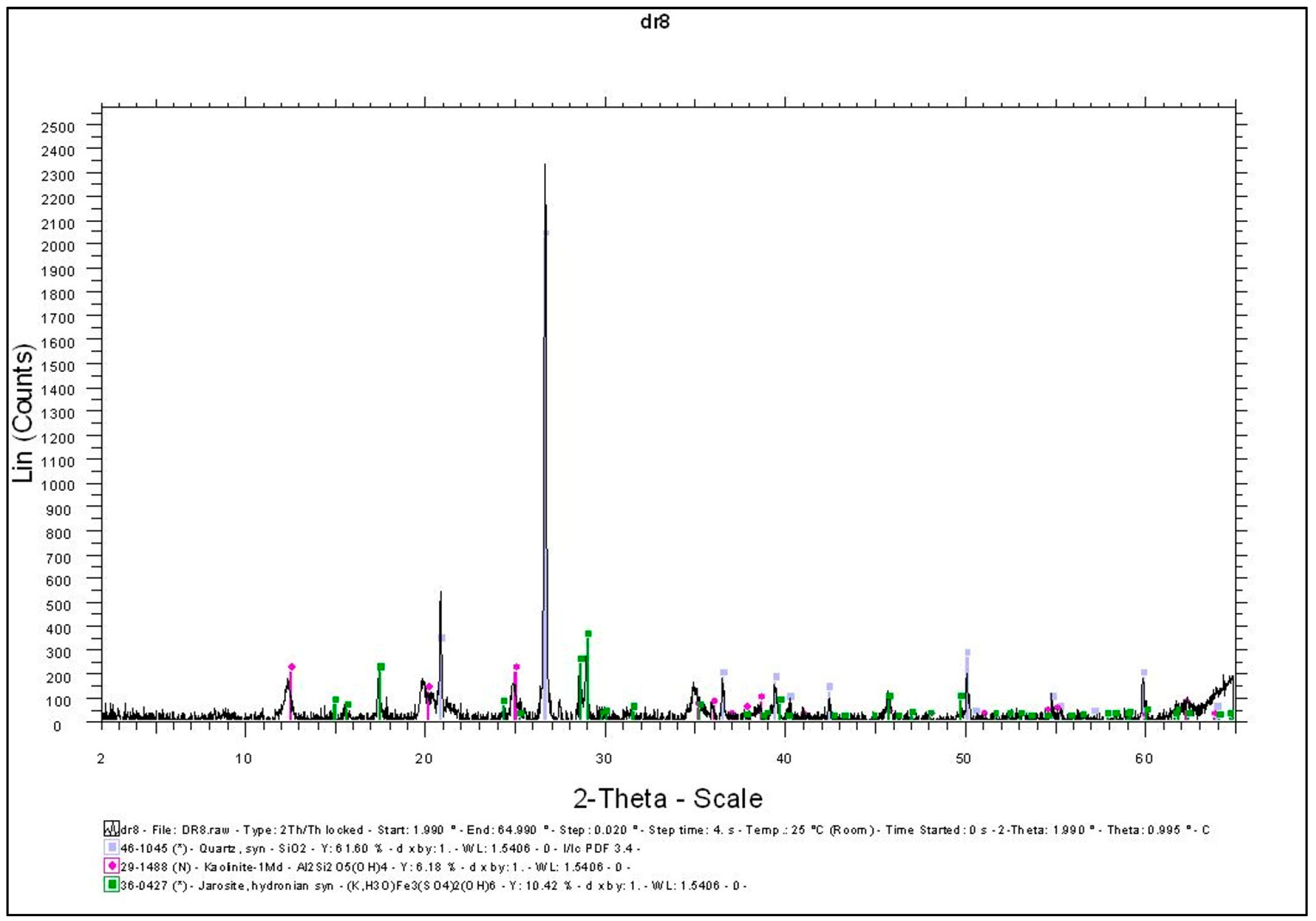


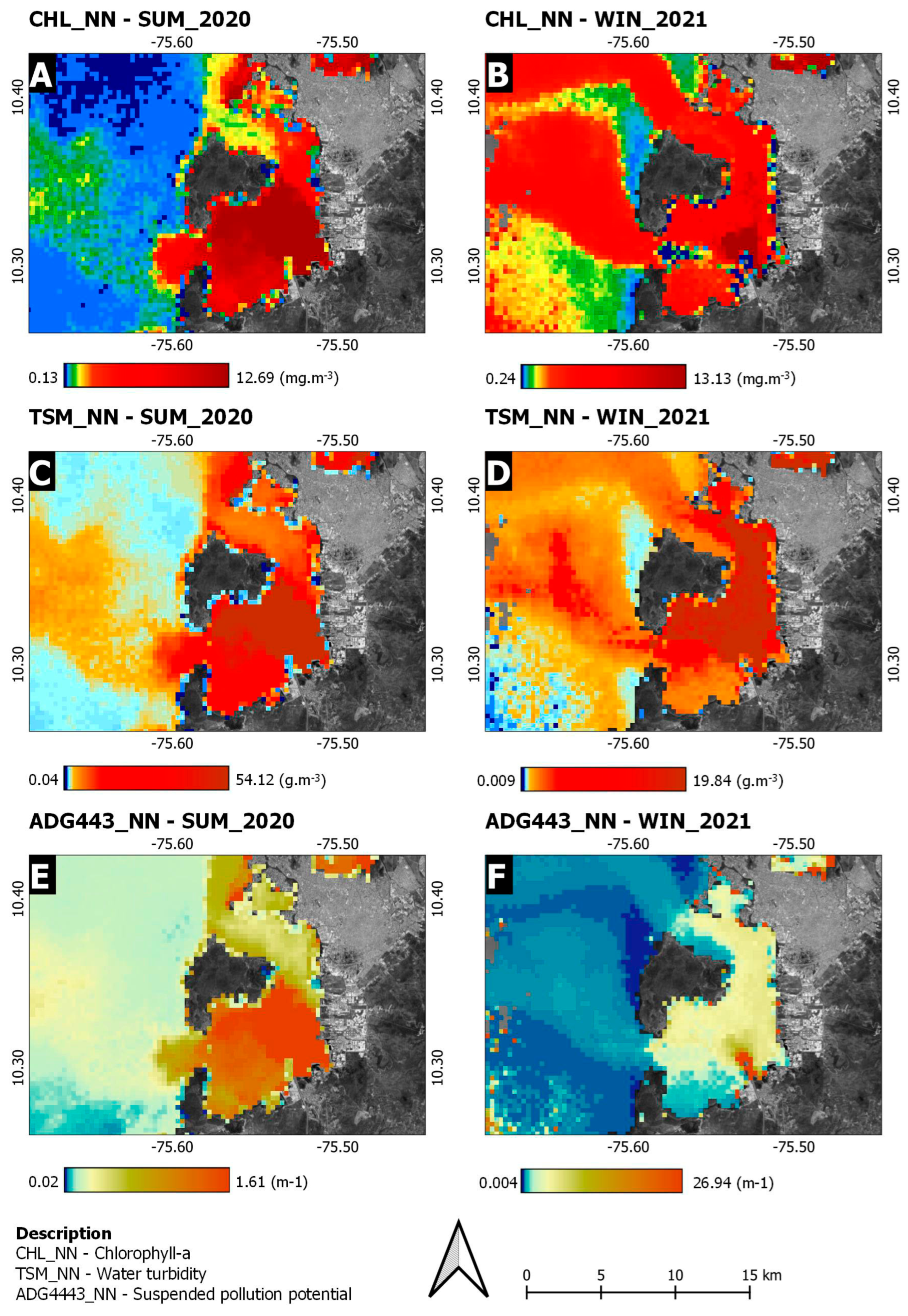
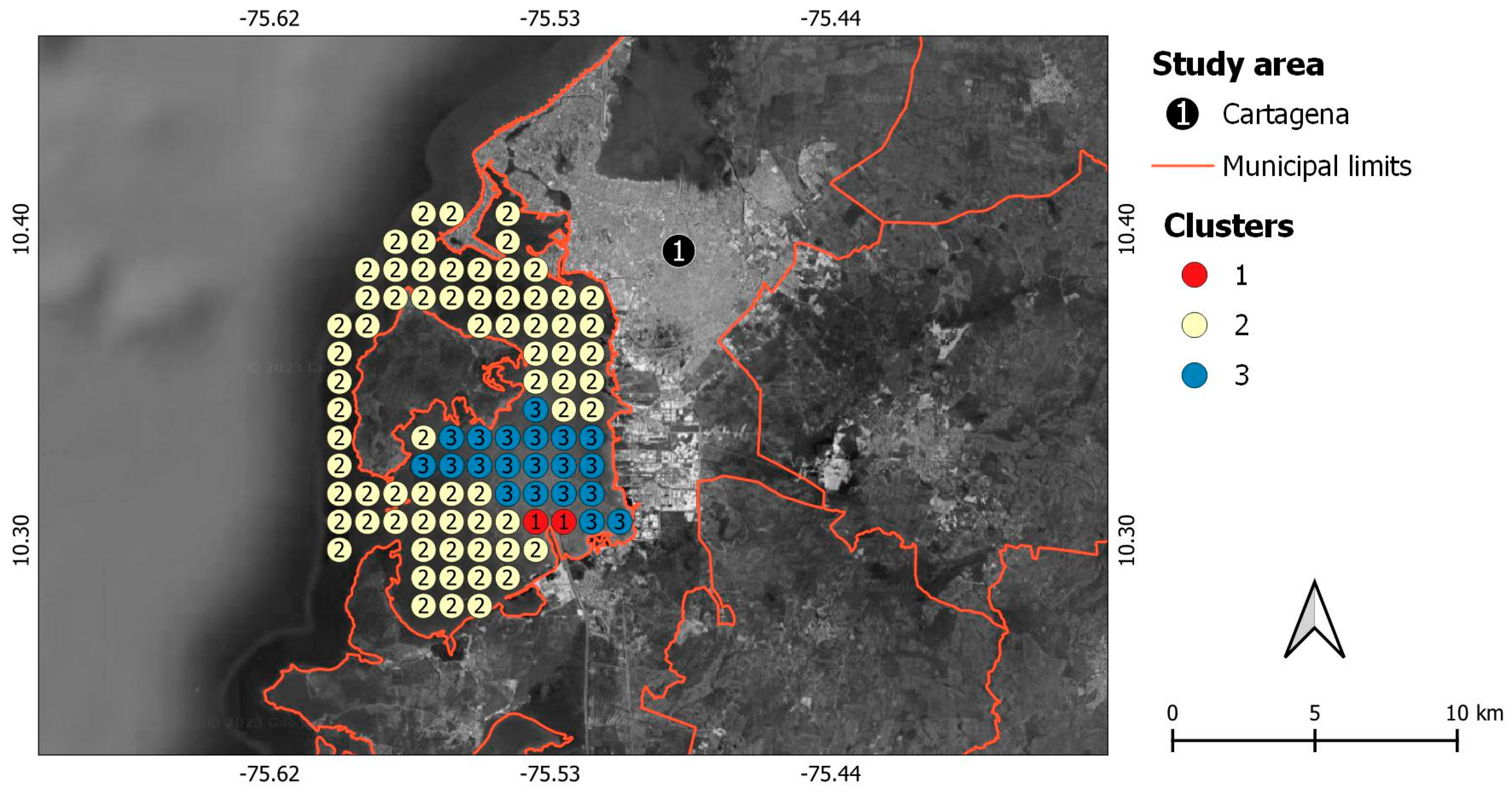
| Identified Mineral | Bocagrande Neighborhood | Isla Tierra Bomba | Playa Blanca |
|---|---|---|---|
| Anatase | x | x | x |
| Anhydrite | - | - | x |
| Bararite | x | x | x |
| Barite | x | x | x |
| Calcite | x | x | x |
| Chromite | - | x | x |
| Chlorite | x | x | x |
| Goethite | x | x | x |
| Halite | x | x | x |
| Hematite | x | x | x |
| Illite | x | x | x |
| Kaolinite | x | x | x |
| Metakaolinite | x | x | x |
| Monazite | x | - | x |
| Quartz | x | x | x |
| Rutile | x | x | x |
| Siderite | - | x | - |
| Gypsum | x | x | x |
| Pyrite | - | x | x |
| Fullerene | x | x | x |
| Amorphous | x | x | x |
| K-Means Clustering | |||||
| Clusters | N | R2 | AIC | BIC | Silhouette |
| 3 | 91 | 0.693 | 201.860 | 247.060 | 0.560 |
| Cluster Information | |||||
| Cluster | 1 | 2 | 3 | ||
| Size | 2 | 69 | 20 | ||
| Explained proportion within-cluster heterogeneity | 0.113 | 0.615 | 0.272 | ||
| Within the sum of squares | 18.786 | 101.971 | 45.106 | ||
| Silhouette score | 0.280 | 0.580 | 0.502 | ||
| Items | CHL_NN | TSM_NN | ADG443_NN | |||
|---|---|---|---|---|---|---|
| Summer 2020 | Winter 2021 | Summer 2020 | Winter 2021 | Summer 2020 | Winter 2021 | |
| Valid | 91 | 91 | 91 | 91 | 91 | 91 |
| Missing | 0 | 0 | 0 | 0 | 0 | 0 |
| Mean | 8.197 | 5.183 | 33.051 | 14.420 | 1.195 | 3.909 |
| Std. Deviation | 6.710 | 3.769 | 35.000 | 29.320 | 0.918 | 5.111 |
| Minimum | 0.182 | 0.064 | 0.964 | 0.157 | 0.111 | 0.074 |
| Maximum | 21.806 | 21.030 | 100.000 | 232.553 | 4.188 | 32.201 |
| Items | CHL_NN | TSM_NN | ADG443_NN | |||
|---|---|---|---|---|---|---|
| Summer 2020 | Winter 2021 | Summer 2020 | Winter 2021 | Summer 2020 | Winter 2021 | |
| Cluster 1 | 1.360 | 1.333 | 1.913 | 6.198 | 2.642 | 5.396 |
| Cluster 2 | −0.460 | −0.287 | −0.514 | −0.231 | −0.481 | −0.242 |
| Cluster 3 | 1.453 | 0.857 | 1.582 | 0.176 | 1.396 | 0.295 |
Disclaimer/Publisher’s Note: The statements, opinions and data contained in all publications are solely those of the individual author(s) and contributor(s) and not of MDPI and/or the editor(s). MDPI and/or the editor(s) disclaim responsibility for any injury to people or property resulting from any ideas, methods, instructions or products referred to in the content. |
© 2024 by the authors. Licensee MDPI, Basel, Switzerland. This article is an open access article distributed under the terms and conditions of the Creative Commons Attribution (CC BY) license (https://creativecommons.org/licenses/by/4.0/).
Share and Cite
Neckel, A.; Taleb, M.F.A.; Ibrahim, M.M.; Moro, L.D.; Mores, G.; Schmitz, G.P.; Bodah, B.W.; Maculan, L.S.; Lermen, R.T.; Ramos, C.G.; et al. Environmental Unsustainability in Cartagena Bay (Colombia): A Sentinel-3B OLCI Satellite Data Analysis and Terrestrial Nanoparticle Quantification. Sustainability 2024, 16, 4639. https://doi.org/10.3390/su16114639
Neckel A, Taleb MFA, Ibrahim MM, Moro LD, Mores G, Schmitz GP, Bodah BW, Maculan LS, Lermen RT, Ramos CG, et al. Environmental Unsustainability in Cartagena Bay (Colombia): A Sentinel-3B OLCI Satellite Data Analysis and Terrestrial Nanoparticle Quantification. Sustainability. 2024; 16(11):4639. https://doi.org/10.3390/su16114639
Chicago/Turabian StyleNeckel, Alcindo, Manal F. Abou Taleb, Mohamed M. Ibrahim, Leila Dal Moro, Giana Mores, Guilherme Peterle Schmitz, Brian William Bodah, Laércio Stolfo Maculan, Richard Thomas Lermen, Claudete Gindri Ramos, and et al. 2024. "Environmental Unsustainability in Cartagena Bay (Colombia): A Sentinel-3B OLCI Satellite Data Analysis and Terrestrial Nanoparticle Quantification" Sustainability 16, no. 11: 4639. https://doi.org/10.3390/su16114639
APA StyleNeckel, A., Taleb, M. F. A., Ibrahim, M. M., Moro, L. D., Mores, G., Schmitz, G. P., Bodah, B. W., Maculan, L. S., Lermen, R. T., Ramos, C. G., & Oliveira, M. L. S. (2024). Environmental Unsustainability in Cartagena Bay (Colombia): A Sentinel-3B OLCI Satellite Data Analysis and Terrestrial Nanoparticle Quantification. Sustainability, 16(11), 4639. https://doi.org/10.3390/su16114639









